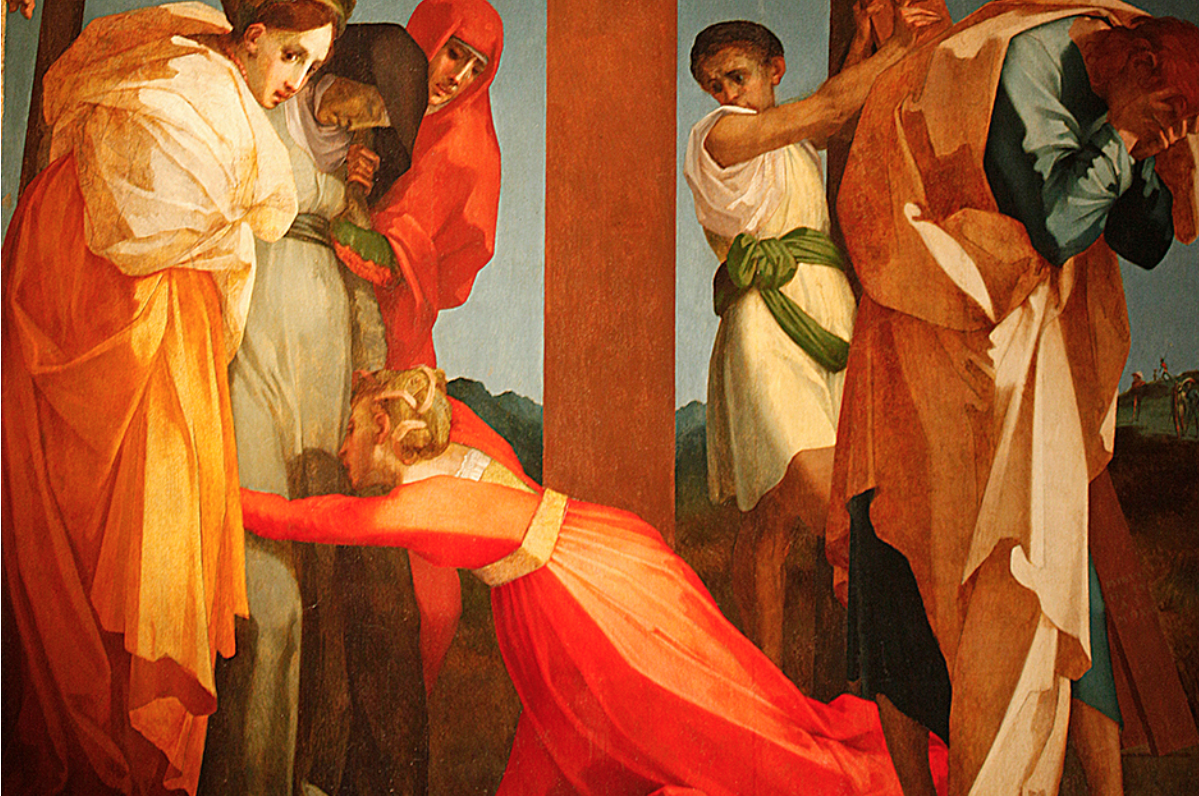
Visitors to Volterra this fall have an exciting treat awaiting them in the Civic Art Museum–after restoration work lasting a year, Rosso Fiorentino’s Descent from the Cross will be unveiled on November 16. Besides admiring this masterpiece of Tuscan Mannerist art, guests can learn about the conservation work and the history of the painting thanks to a presentation. Conservators Daniele Rossi and Roberto Buda headed a team of scientists using diagnostics to delve beneath the surface of the altarpiece to reveal Rosso’s technique and document the condition of the paint layers and of the large wooden panel. The conservation and scientific research were funded by the Friends of Florence Foundation.
The altarpiece, originally in the Cathedral of Volterra, was signed and dated by the artist in 1521, when Giovanni Battista di Jacopo (1495 – 1540), known to his contemporaries as Rosso Fiorentino because of his Florentine heritage and his shock of brilliant red hair, was 27. Rosso had apprenticed in the workshop of master Florentine painter Andrea del Sarto from his mid-teens and by the time of his Volterra commission was a sought-after artist in his own right. Considered by many scholars to be Rosso Fiorentino’s greatest work, his Descent from the Cross is an intense study in movement, color and raw emotion that marked a new era in Mannerist painting.
The term “Mannerism” has been a subject of more or less continuous discussion in art history since the term “la maniera moderna” was first coined by Vasari to describe the painters and architects of his generation. Artists such as Bronzino, Parmigianino, Pontormo, Rosso and Vasari himself in Florence, Beccafumi and Sodoma in Siena, and Giulio Romano in Rome expressed different aspects of the new style. Mannerism is a highly sophisticated art form, founded on supreme technical competence and utter familiarity with the High Renaissance style.
Mannerist adherents pushed the main features of the High Renaissance canon, i.e. perspective, architectural volumes, naturalism, beyond their extreme limits. In their works, we sense a continual tension between the real and the ideal, between the natural and the artificial, between the scale of the figures represented and the background they seem to be set into. The seeds of Mannerism can already be found in the painting of Filippino Lippi and in the painting and architecture of Michelangelo. The frenetic compositions of Filippino and Michelangelo’s bold use of color are both echoed in Rosso Fiorentino’s works.
The Descent from the Cross depicts the moment, recounted in the gospel, when the followers of Christ remove His dead body from the cross. This theme first became popular in Byzantine art in the 9th century and was further developed in the later Medieval and Reniassance eras. Mannerist painters interpreted the theme in new ways, and Rosso Fiorentino’s depiction is certainly the most revolutionary of them all.
Art historians have attributed Rosso’s strange composition of the Descent from the Cross, with its figures crowded towards the edges of the painting, as a Mannerist overreaction to the harmonious compositions of the High Renaissance. However, later scholars have pointed out that the painting was made for the high altar of a chapel in the Volterra Cathedral dedicated to the story of the true cross, a central theme for the Franciscan friars who commissioned the piece. So, the boldly painted cross at the center of Rosso’s composition, starkly outlined against the sky, is central to our understanding the meaning of the painting. The cross links the still, peaceful figure of Christ, whose spirit has already ascended to Heaven, with the violently active figures on the ladders next to him and the grieving figures at the bottom of the picture, who are closest to the viewers.
Rosso’s harsh lighting seems to capture the scene in a brief, agonizing moment of time. The colors in Descent from the Cross are bold, dramatic, and dissonant, inspiring feelings of anguish and uncertainty, heightened by the awkward movements of the figures on the ladders. The body of Christ is a sickly green hue, his reddish hair contrasting with the cadaverous tones of his skin. The boldness of Rosso’s modelling, with faces and drapery seemingly sculpted by a chisel rather than shaped by brushstrokes, recalls Michelangelo but also foretells the 20th century Cubist style.
The background of the painting is almost non-existent, as if the figures are actors on a stage set. Besides Christ, there are 10 participants, who are not all identifiable but who include: Joseph of Arimathea, (the man with the grey beard) Nicodemus (reaching out to support the body), and at the bottom of the composition, St. John the Evangelist, the Virgin Mary, and Mary Magdalene (who throws herself at Mary’s feet).
Rosso’s St. John the Evangelist, a tall red-headed man stooped over in grief at the bottom right, is considered to be a self-portrait of the artist. By including himself in the composition, Rosso heightens the emotional intensity of his work and of our involvement in it. The position he is in, stooped over in anguish with his head buried in his hands, accentuates this. Ditto for the figure of Mary Magdalene, reaching across the bottom of the cross to almost claw at the Virgin’s cloak in her horror and distress at the scene, and we can identify with her grief. It’s no wonder that in 1963 the great Italian director Pier Paolo Pasolini chose to create a tableau vivant of Rosso’s incredibly communicative masterpiece.
The conservation process in Volterra has shed new light on the Descent from the Cross, and further our knowledge of Rosso Fiorentino and his art. Museum hours are 9 am – 7 pm. (Elizabeth Wicks)








